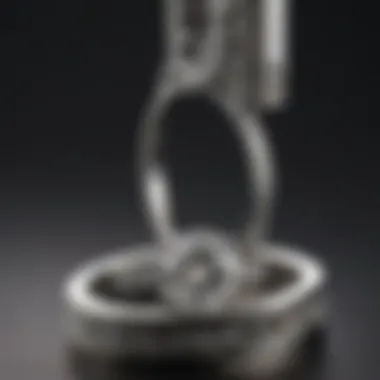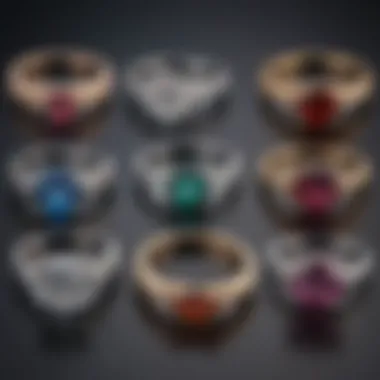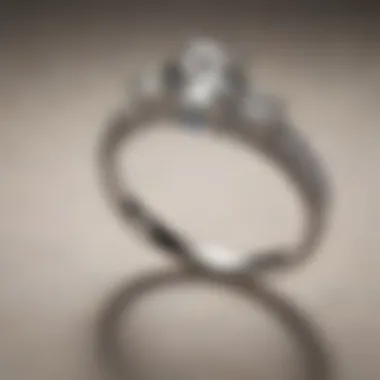The Complete Guide to Resizing Engagement Rings


Intro
Engagement rings hold a significant place in human tradition, symbolizing not just commitment but also love. However, the journey of an engagement ring does not end at the proposal. Resizing is a common consideration for many individuals, especially as life changes occur. The nuances of this process are often overlooked. Understanding resizing helps one appreciate the journey a ring takes to fit perfectly on a finger.
In this guide, we will delve into the aspects of resizing engagement rings, exploring methods, costs, and timeframes. We will emphasize the importance of professional consultation and address common concerns surrounding the resizing process.
Overview of Resizing Engagement Rings
Resizing an engagement ring is a delicate task. Many factors influence the decision to resize, such as changes in finger size due to weight gain, loss, or pregnancy. Choosing the right method is crucial.
Methods of Resizing
There are primarily two methods for resizing rings: increasing size and decreasing size.
- Increasing Size: This method involves stretching the metal to make the ring larger. Jewellers may add material, but it can change the ring's integrity.
- Decreasing Size: This process requires cutting the band and soldering it back together. It usually retains the ring's original structure better than increasing size.
Costs of Resizing
The cost of resizing can vary significantly depending on
- the materials used
- the complexity of the change
- the jeweler's experience.
Typically, prices can range from $20 to $150. For intricate designs, costs may be higher.
Timeframe Considerations
The time needed for resizing varies widely. Simple resizes can take a few hours, while intricate designs may require several days. It’s always beneficial to inquire about time before committing to either a ring redesign or resizing.
Consultation with a Professional Jeweller
Consulting a jeweler is critical. Their expertise ensures that no damage occurs during the resizing process. They can also offer advice on ring maintenance, gemstones, and potential design adjustments.
A professional jeweler not only provides resizing services but also ensures the ring's overall health and integrity remain intact.
With the right knowledge and preparation, the resizing of an engagement ring can be a straightforward process. Understanding these factors helps ensure a perfect fit for a cherished symbol of love.
Understanding Engagement Ring Resizing
Resizing an engagement ring is more than just a simple adjustment. This process holds significant importance for both aesthetic and comfort reasons. A ring that fits poorly can be uncomfortable to wear and may even pose a risk of loss. Therefore, it is crucial to understand the basics of resizing. This understanding allows individuals to make decisions that ensure the ring retains its beauty and integrity while providing the wearer with the comfort they desire.
When it comes to engagement ring resizing, many feel uncertain about the methods involved and the potential impact on the ring's overall structure. Gaining knowledge about this topic can alleviate many concerns and lead to informed choices when engaging with jewelers. Proper resizing can maintain the original design's integrity while accommodating personal comfort.
Why Resizing is Necessary
Resizing is often necessary due to various life changes. For instance, weight fluctuations can affect finger size. This is not uncommon and happens to many people. Additionally, seasonal changes can lead to slight variations in finger size. Hot weather can cause fingers to swell, while cold weather can make them shrink.
Moreover, engagements often bring emotional changes too. It is symbolic of a promise, and ensuring the ring fits correctly is essential for many. A well-fitted ring conveys the wearer's personal investment and sentiment in the relationship.
Here are some reasons why resizing may be necessary:
- Weight Changes: Fluctuations in body weight can lead to changes in finger size.
- Temperature Variations: Seasonal changes may affect how well the ring fits.
- Emotional Connections: The ring symbolizes a commitment, and a proper fit reflects the wearer’s love and dedication.
When to Consider Resizing
Knowing when to consider resizing an engagement ring is vital. Several indicators can signal the need for resizing. If the ring feels tight and is difficult to take off, or if it is too loose and shifts on the finger, these are clear signs that something needs to be done. Also, if the ring has been bought as a surprise, there is a chance that it may not fit perfectly. In such cases, it is wise to consult a professional jeweler soon after the engagement.
Consider resizing if:
- The Ring is Difficult to Remove: If it feels tight, resizing may be necessary to prevent potential injury.
- The Ring Spins on the Finger: If the ring frequently shifts, resizing can enhance comfort and appearance.
- Recent Life Changes: Any significant weight gain or loss should prompt a reassessment of ring size.
Understanding these details about resizing engagement rings can support individuals in maintaining both the physical and emotional significance of their rings.
Methods of Resizing Engagement Rings
Resizing engagement rings is vital for ensuring that the ring fits comfortably while maintaining its aesthetic value. There are several methods jewellers employ to achieve this, each with its own set of benefits and considerations. Understanding these methods helps one to make informed choices tailored to individual ring characteristics.


Increasing the Size
Stretching Techniques
Stretching techniques allow for a gentle increase in the ring's size without altering its original design significantly. This method is particularly beneficial for rings made of metals like gold or platinum that can be expanded slightly.
The key characteristic of stretching techniques is that they use pressure to enlarge the band. This method is non-invasive and often preserves the ring's delicate details. It is a popular choice because it does not require additional materials and can be a quick process. However, it is essential to note that stretching has its limitations; rings with intricate designs, or those containing specific settings, may not be suitable for this method as excess stretching can weaken the structure.
Adding Metal
Adding metal is another effective strategy for increasing the size of an engagement ring. In this method, a skilled jeweler will add a piece of metal, typically gold or platinum, to the band. This approach is beneficial when the increase needed in size is substantial.
The key feature of adding metal is that it allows for more considerable adjustments compared to stretching. It ensures that the integrity and durability of the ring remain intact. However, this method can alter the original style of the ring, depending on how the addition is integrated. One advantage is that it can enhance the ring's appearance if done correctly, but the drawback is the increased cost and potential for mismatched metal shades if the added metal does not blend seamlessly with the original ring.
Decreasing the Size
Soldering
Soldering is commonly used to decrease the size of a ring. In this technique, a jeweler will cut the band and then melt metal to join the ends together. This method is effective for creating a snug fit.
The key characteristic of soldering is its precision; skilled hands can ensure that the cut is minimal and the ring maintains a neat appearance after resizing. This technique is suitable for most types of metals. Its major disadvantage is the potential for visible seams, especially if the soldering is not executed properly. Care must also be taken when resizing rings with delicate gemstones, as the heat can affect them.
Creating a Channel
Creating a channel involves cutting a small section out of the band and reshaping it, thus decreasing the ring's overall size. This method is beneficial for achieving a perfect fit without compromising the design.
The unique feature of creating a channel is the clean finish it provides. It allows for reconstruction of the ring while preventing the disadvantages typically associated with other resizing methods. However, this technique is more complex and may take additional time and expertise, making it potentially costlier. It is recommended for rings with subtle designs, as intricate patterns may not be easily replicated after resizing.
Each method of resizing engagement rings has its advantages and drawbacks, making it crucial to consult a qualified jeweler to find the right solution for your specific needs.
Considerations Before Resizing
Resizing an engagement ring is not a trivial task. Various factors influence the potential outcomes and longevity of the ring. Understanding these considerations is essential for a successful resizing process. Engaging with these points ensures that the ring retains its aesthetic appeal and structural integrity, while also being comfortable for the wearer.
Ring Material
The material of the ring plays a crucial role in the resizing process. Different metals respond uniquely to resizing techniques. For example, gold is more malleable, making it easier to resize. On the other hand, platinum, though stronger, tends to require more expertise during resizing, often resulting in higher costs. Other materials, such as titanium or tungsten, can be challenging to resize due to their hardness. It's important to evaluate the ring's metal to determine the proper technique and whether resizing is feasible at all.
Stone Settings
The way a stone is set can greatly affect the resizing process. Some settings, like prong or bezel, may allow more room for adjustment. However, certain complex settings, such as tension settings, may limit how much the ring can be resized. If the stones are well-secured and the setting is adaptable, resizing can be done effectively. Yet, an improper handling could lead to stones becoming loose or misaligned. Thus, consulting a professional jeweler who can assess the settings and advise accordingly is indispensable.
Current Size and Fit
Understanding the current size and fit of the ring is pivotal. Too tight and it may cause discomfort, too loose and it risks slipping off. Wearers should consider their current circumstances, such as weight changes or fluctuating finger sizes due to temperature or health issues. Taking accurate measurements is thus essential. Ring sizers or visiting a jeweler can provide a definitive size. This data enables one to make informed choices during the resizing process, ultimately ensuring a more comfortable and reliable fit.
Remember: Always prioritize the integrity of the ring over aesthetics. Consulting with professionals ensures you preserve its value and beauty.
Choosing a Jeweler for Resizing
Choosing the right jeweler for resizing an engagement ring is crucial. An improper resizing can damage the ring or even the gemstones set within it. Thus, it is important to approach this decision with care. A qualified jeweler can provide insights into the resizing process, ensuring the ring's integrity is maintained.
Finding a Qualified Professional
When searching for a jeweler, consider several factors. First, look for certified professionals with experience in resizing. Certifications can include those from organizations such as the Gemological Institute of America (GIA) or the American Gem Society (AGS).
Research local jewelers online and read customer reviews. Online platforms provide opinions from previous clients. Positive experiences can be a good indicator of quality work. Furthermore, visiting the store in person allows you to assess the jeweler’s skill level and customer service.
Also, ask for recommendations from friends or family who have undergone similar processes. Their firsthand experiences can help guide your choice. Always ensure that the jeweler is reputable. Check for any complaints with business organizations.
Evaluating Experience with Different Gemstones
Not all jewelers work with every type of gemstone. It is important to verify a jeweler's experience with the specific stones in your ring. For example, resizing settings with delicate or rare gemstones like opals or emeralds requires extra attention.


In your discussions with the jeweler, inquire about their past experiences with resizing rings that have similar components to yours. Here are some questions you might ask:
- What is your experience with this type of gemstone?
- How do you handle fragile stones during the resizing process?
- Can you show examples of previous work on similar rings?
By ensuring the jeweler has the right experience, you can prepare yourself for a satisfactory resizing. The care taken with the gemstone will affect the overall appearance and value of the ring post-resizing.
It is vital to select a jeweler who understands the complexities of various gemstones to avoid damage during resizing.
Cost of Resizing an Engagement Ring
Understanding the cost associated with resizing an engagement ring is crucial for anyone considering this option. The expenses can vary widely based on several factors, impacting the final decision. Different resizing methods can lead to different costs. Furthermore, the choice of jeweler also plays a significant role in the financial aspect. By keeping these elements in mind, individuals can budget effectively and choose the best resizing option that meets their needs.
Factors Affecting Cost
Complexity of the Resize
The complexity of the resize is a notable factor influencing the overall cost. Some rings are designed in intricate styles that may require specialized techniques to resize appropriately. For example, rings with elaborate settings or multiple stones can demand more skill and time from a jeweler. This added labor can lead to higher prices.
A key characteristic of complex resizing lies in its potential to alter the ring's balance and aesthetics. Having a qualified jeweler assess the situation is essential before proceeding with such work. If the design is not straightforward, it may result in unexpected challenges.
Advantages of complex resizing include:
- Customization: The jeweler can provide a tailored approach to the resizing process.
- Durability: Proper resizing can enhance the ring's longevity when handled by an expert.
Disadvantages may include:
- Higher Costs: The more detailed the work, the more expensive it becomes.
- Longer Duration: Complex methods often take additional time to complete.
Jeweler's Expertise
The jeweler's expertise significantly affects the resizing cost as well. An experienced jeweler is likely to charge more than a novice. However, their skills can also lead to better results. Selecting a jeweler with appropriate credentials ensures that your ring is resized without compromising its quality or design.
A key feature of skilled jewelers is their proficiency with various types of settings and metals. This background allows them to make informed decisions during the resizing process, thus ensuring satisfaction.
Advantages of hiring an expert include:
- Quality Assurance: Well-trained jewelers are less likely to make mistakes.
- Advice and Guidance: An experienced jeweler can advise on the best resizing method for specific rings.
Disadvantages may involve:
- Premium Pricing: Highly skilled professionals often charge premium fees.
- Limited Availability: Some experts may be booked well in advance, delaying the resizing process.
Average Price Range
Estimating the average price range for resizing an engagement ring is essential for financial planning. Typically, resizing can cost anywhere from $20 to $100. The starting point often depends on the ring's material and the type of resizing method chosen.
To provide clarity, here is a breakdown of common price ranges based on various factors:
- Simple resizing (for rings without complicated settings): $20 - $50
- Moderate resizing (for rings with some detail): $50 - $75
- Complex resizing (for ornate designs or multiple settings): $75 - $150
Understanding the nuances of costs associated with resizing will prepare you for informed discussions with your jeweler.
Timeframe for Resizing
Understanding the timeframe for resizing an engagement ring is crucial for any individual considering this process. Different factors can influence how long the resizing may take. Properly assessing the time needed helps manage expectations and ensures that any important events, such as an engagement or anniversary, are accommodated.
Additionally, awareness of the resizing duration aids in making informed decisions about the urgency of the work. Jewelry, especially engagement rings, often carries emotional and personal significance, making any delay in receiving the resized ring potentially disappointing.
Typical Resizing Duration
The typical duration for resizing an engagement ring can vary. Most alterations can take anywhere from
- One day to two weeks, depending on complexity and jeweler workload.
- Simple resizing might only take a day.
- More complex alterations that involve adjusting settings or adding additional materials may require more time.


For those who seek to resize their rings, the best approach is to consult directly with the jeweler. They can provide a more accurate timeline based on the specific requirements of the ring and their current workload. It is also helpful to ask about typical turnaround times when choosing a jeweler.
Rush Services and Their Implications
In some cases, individuals may require rush services to receive a resized ring quickly. Jewelers often offer expedited services for an additional fee. Here are some key considerations when opting for rush resizing:
- Cost: Expect to pay a premium for faster service. This is often a flat fee or a percentage of the resizing cost.
- Quality Assurance: Rushing can sometimes compromise quality. Verify with the jeweler that quality will not be sacrificed, even with expedited service.
- Availability: Not all jewelers provide rush options. Inquire beforehand to avoid potential delays.
"Rushing the resizing process can lead to mistakes or oversights, potentially diminishing the ring's integrity."
It's essential to weigh the need for speed against the potential trade-offs in quality. Ultimately, how soon you need the ring may guide your decision, but thorough communication with the jeweler is vital to achieving the desired outcome without compromising on quality.
Maintaining the Integrity of the Ring
Maintaining the integrity of an engagement ring is crucial not only for aesthetic reasons but also for preserving its sentimental value. An engagement ring carries a history, symbolizing love and commitment. This means that any alterations, especially resizing, must be approached with care to ensure that the ring retains its original character and durability.
When resizing, the integrity of the ring involves careful attention to the materials used, the craftsmanship involved, and the setting of the stones. These elements can significantly impact both the appearance and structural strength of the ring. Proper maintenance further accentuates the ring’s beauty and longevity.
Post-Resizing Care Guidelines
After resizing an engagement ring, it is essential to follow specific care guidelines. This helps to ensure that the ring remains in excellent condition and continues to symbolize the commitment it represents. Here are some essential care tips:
- Regular Cleaning: Clean your ring regularly with a mild soap solution and a soft brush. Avoid harsh chemicals that can damage the metal or stones.
- Avoiding Impact: Take off the ring when engaging in activities that may subject it to impact or scratches. This includes sports, gardening, and cleaning.
- Storing Properly: Store the ring in a soft-lined box or compartment to prevent scratches or tangles with other jewelry pieces.
- Periodic Checkups: Get your ring checked by a professional jeweler at least once a year. They can identify any loose stones or signs of wear that need addressing.
Following these guidelines not only helps maintain the ring's appearance but also addresses potential issues before they become significant problems.
Common Issues After Resizing
Even with the best care, some issues may arise after resizing an engagement ring. It is important to be aware of these potential problems to deal with them effectively:
- Misalignment of Stones: During the resizing process, stones might shift out of place. This can result in a misalignment that affects the visual appeal of the ring.
- Uneven Band Width: If resizing is not done correctly, the thickness of the band might end up uneven, leading to discomfort or an imbalanced appearance.
- Discoloration: Depending on the metal used and the resizing method, there’s a possibility of discoloration or changes in finish, particularly in plated metals.
- Stress Fractures: Sometimes resizing can put stress on the metal, leading to cracks or fractures, especially in delicate settings or unusual materials.
Dealing with these issues promptly can prevent further complications and ensure the ring remains a cherished item for years to come.
Common Concerns and Questions
Engagement ring resizing raises many common concerns and questions among individuals. It’s essential to address these queries to clarify any misconceptions and provide valuable insights. Understanding the implications of resizing can guide users in making important decisions related to their jewelry.
Will the Resizing Affect the Ring’s Value?
One primary question revolves around the potential impact of resizing on a ring's value. The answer is nuanced. In general, resizing does not need to diminish the intrinsic worth of a ring if performed professionally. However, several factors can play a role in this equation.
- Quality of Work: If the resizing is done poorly, it might affect the structural integrity, leading to a decline in value.
- Authenticity of Stones: For rings with rare or significant stones, any alteration to their setting during resizing can affect their perceived value.
- Market Trends: Sometimes, the value of a ring can fluctuate due to market conditions, independent of resizing.
Can Any Ring Be Resized?
This question often arises due to the diverse world of engagement rings. The short answer is that most rings can be resized, but with specific limitations. Different materials and designs can influence the feasibility of resizing.
- Material Type: For example, platinum and gold are generally easier to resize compared to Tungsten or titanium.
- Complexity of Design: Rings with intricate settings or unique designs may pose challenges. For instance, halo settings may require additional adjustments to keep the look consistent.
- Condition of the Ring: Older rings or those that have already undergone resizing may have limitations on how much they can be resized again.
In summary, while many rings can be resized, consultation with a skilled jeweler is essential to assess the potential challenges and ensure the ring’s integrity remains intact.
End
Resizing an engagement ring is not just a technical task; it carries significant emotional weight. Understanding the complexities involved is crucial for anyone considering this process. This article highlights key elements such as methods, costs, and timelines, providing readers with a clear picture of what to expect.
Making Informed Choices
When it comes to resizing an engagement ring, informed decision-making is essential. Many factors play a role in how and when to resize. Firstly, understanding the size and fit ensures that you are not merely reacting to temporary changes, like weight fluctuations. Consider the material of the ring; metals behave differently when resized. Gold, for example, can be stretched or compressed more easily than platinum.
Additionally, examine the stone settings closely. If a ring holds precious stones, their layout may dictate whether resizing is feasible without compromising integrity. Prioritizing the ring's aesthetic appeal and originality while making these decisions is crucial.
The Value of Professional Help
Engaging a professional jeweler cannot be understated. Their expertise ensures that resizing is performed safely and accurately. A qualified jeweler can assess the ring's structure, suggest the best methods, and anticipate potential issues. They also understand the importance of maintaining the ring's resale value and can guide you through that process.
Left in the hands of amateurs, a sought-after piece risks damage. As the jewelers possess the right tools and knowledge, investing in professional help is not merely an expense; it's a safeguard for your cherished possession.
In essence, consulting a jeweler not only preserves integrity but also enhances your experience of wearing a resized ring, making the transition seamless and gratifying.







